(Naples 1634–1705) Saint Simon, oil on canvas, 75.5 x 63 cm, framed Provenance: Aristocratic collection, until 1992; Private European collection Exhibited: Naples, Castel Sant’Elmo/Vienna, Kunsthistorisches Museum, Luca Giordano 1634-1705, 3 March – 3 June 2001 / 23 June – 7 October 2001, cat. no. 53b (as Luca Giordano Literature: V. Pacelli Inediti di Luca Giordano in: Napoli, l’Europa. Ricerche di storia dell’arte in onore di Ferdinando Bologna, ed. by F. Abbate/F. Sricchia Santoro, Catanzaro 1995, p. 243, fig. 196 (as Luca Giordano ; D. M. Pagano, in: Luca Giordano 1634-1705, exhibition catalogue, ed. by W. Seipel, Naples/Vienna 2001, pp. 186-187, cat. no. 53b (as Luca Giordano ; O. Ferrari/G. Scavizzi, Luca Giordano nuove ricerche e inediti, Naples 2003, cat. no. A016B (as Luca Giordano Saint Simon is depicted against a dark background. In one hand the Apostle holds a book on which his name is written and in the other hand he holds a saw, which was the instrument of his martyrdom. Luca Giordano used vigorous brush-marks to render Simon’s beard: the media are diluted, light, impregnated with colour, penetrates the beard and the effects of chiaroscuro are diffused, suggesting a date of 1650 for the present composition (see O. Ferrari, G. Scavizzi in literature). In Giordano’s oeuvre it is possible to recognise that certain aspects of the modelling of this Saint Simon are recurrent. Indeed, the Saint Paul the Hermit in the Gemäldegalerie, Dresden (see fig. 1), is not only similar in composition and handling of paint, but also the features of the protagonists are alike. Jusepe de Ribera whose series called the Apostolado in the Prado has survived almost intact, supplied the prototype for the present painting. Shared features include the frontal view of the figure, the illumination conforming closely to the example of Caravaggio, with a light source from the left that highlights the noble features of the figure, against a dark background that is softened on the right by a brighter area. This kind of iconography, representing a saint half-length against a dark background, accompanied only by an attribute, is typical of Ribera and the present painting can be compared to the Saint Simon by Ribera in the Prado (inv. no. P001091). In addition to his inclination to summarise the character of the subject by emphasising sentiment and emotion, Luca Giordano reveals his deep understanding of Ribera’s strikingly naturalistic renderings, that are marked by a strong religious sentiment, a participatory feeling for the intimate, and an awareness of the pained condition of humanity scarred by age and suffering. During the earliest period of his training in his native city Luca Giordano learnt the rudiments of the Caravaggist tradition in Naples. After the death of Ribera in 1652, the still youthful Giordano travelled to Rome. Here his palette gained a vibrancy of colour, while he also acquired a new freedom of expression, particularly in the wake of his journey to Venice where, in 1674, he signed the canvases for Santa Maria della Salute. Additionally, he executed prestigious commissions in Naples, Padua, Florence and elsewhere. He was subsequently called to Spain from 1692 to 1702 where, at the court of King Charles II, he executed important decorative cycles in the cathedral in Toledo and in the Palacio del Buen Retiro in Madrid.
(Naples 1634–1705) Saint Simon, oil on canvas, 75.5 x 63 cm, framed Provenance: Aristocratic collection, until 1992; Private European collection Exhibited: Naples, Castel Sant’Elmo/Vienna, Kunsthistorisches Museum, Luca Giordano 1634-1705, 3 March – 3 June 2001 / 23 June – 7 October 2001, cat. no. 53b (as Luca Giordano Literature: V. Pacelli Inediti di Luca Giordano in: Napoli, l’Europa. Ricerche di storia dell’arte in onore di Ferdinando Bologna, ed. by F. Abbate/F. Sricchia Santoro, Catanzaro 1995, p. 243, fig. 196 (as Luca Giordano ; D. M. Pagano, in: Luca Giordano 1634-1705, exhibition catalogue, ed. by W. Seipel, Naples/Vienna 2001, pp. 186-187, cat. no. 53b (as Luca Giordano ; O. Ferrari/G. Scavizzi, Luca Giordano nuove ricerche e inediti, Naples 2003, cat. no. A016B (as Luca Giordano Saint Simon is depicted against a dark background. In one hand the Apostle holds a book on which his name is written and in the other hand he holds a saw, which was the instrument of his martyrdom. Luca Giordano used vigorous brush-marks to render Simon’s beard: the media are diluted, light, impregnated with colour, penetrates the beard and the effects of chiaroscuro are diffused, suggesting a date of 1650 for the present composition (see O. Ferrari, G. Scavizzi in literature). In Giordano’s oeuvre it is possible to recognise that certain aspects of the modelling of this Saint Simon are recurrent. Indeed, the Saint Paul the Hermit in the Gemäldegalerie, Dresden (see fig. 1), is not only similar in composition and handling of paint, but also the features of the protagonists are alike. Jusepe de Ribera whose series called the Apostolado in the Prado has survived almost intact, supplied the prototype for the present painting. Shared features include the frontal view of the figure, the illumination conforming closely to the example of Caravaggio, with a light source from the left that highlights the noble features of the figure, against a dark background that is softened on the right by a brighter area. This kind of iconography, representing a saint half-length against a dark background, accompanied only by an attribute, is typical of Ribera and the present painting can be compared to the Saint Simon by Ribera in the Prado (inv. no. P001091). In addition to his inclination to summarise the character of the subject by emphasising sentiment and emotion, Luca Giordano reveals his deep understanding of Ribera’s strikingly naturalistic renderings, that are marked by a strong religious sentiment, a participatory feeling for the intimate, and an awareness of the pained condition of humanity scarred by age and suffering. During the earliest period of his training in his native city Luca Giordano learnt the rudiments of the Caravaggist tradition in Naples. After the death of Ribera in 1652, the still youthful Giordano travelled to Rome. Here his palette gained a vibrancy of colour, while he also acquired a new freedom of expression, particularly in the wake of his journey to Venice where, in 1674, he signed the canvases for Santa Maria della Salute. Additionally, he executed prestigious commissions in Naples, Padua, Florence and elsewhere. He was subsequently called to Spain from 1692 to 1702 where, at the court of King Charles II, he executed important decorative cycles in the cathedral in Toledo and in the Palacio del Buen Retiro in Madrid.
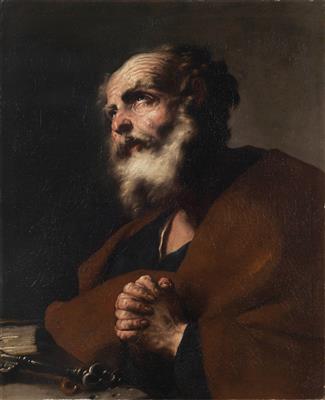
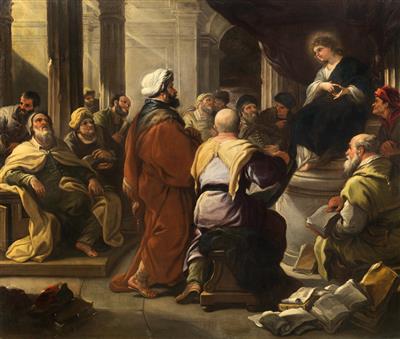
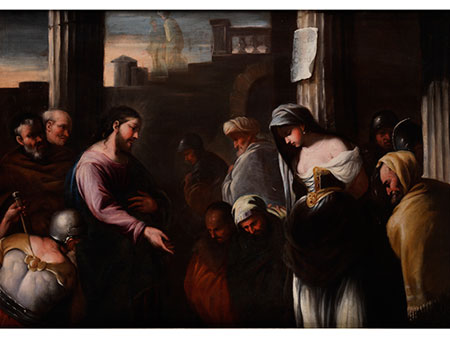






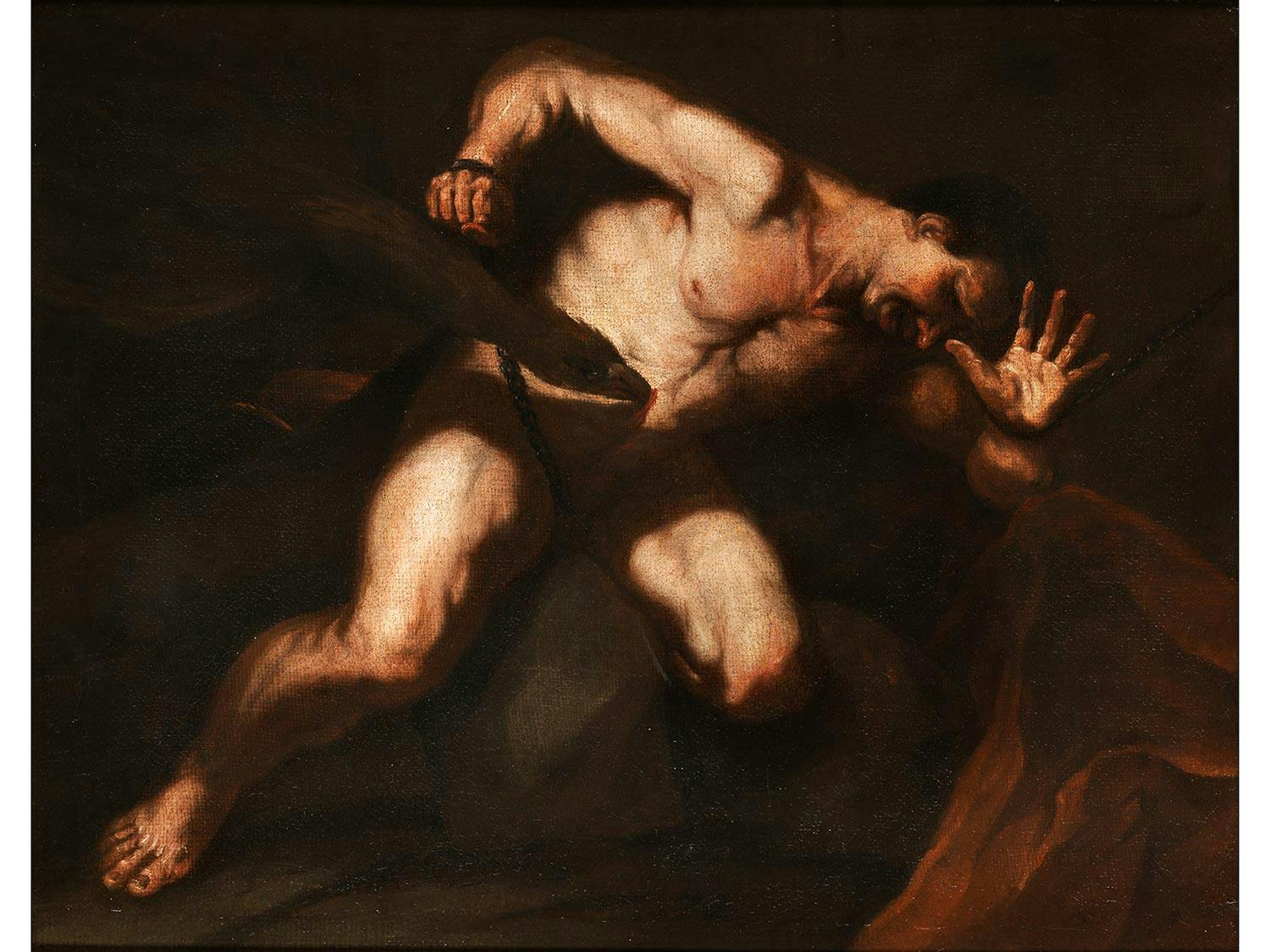
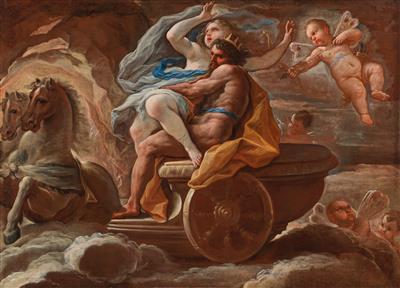




Try LotSearch and its premium features for 7 days - without any costs!
Be notified automatically about new items in upcoming auctions.
Create an alert